|
HRO “Commit to Zero Harm in a Culture of Excellence” is a quarterly newsletter designed to support HRO Champions, Leads, and workgroups by featuring high reliability actions and initiatives.
HRO Links:
VHA's Journey to High Reliability (sharepoint.com)
VISN 22 Systems Redesign - V22 High Reliability Journey (sharepoint.com)
VISN 22 HRO Community of Practice Teams Channel
 |
|
Leadership Commitment |
Message from your VISN 22 Network Director
Mr. Michael W. Fisher
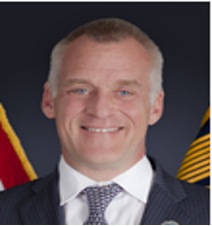
A healthy learning organization is a place where employees want to serve, and Veterans want to receive services. You help to influence work experiences and inform leaders where we want to prioritize change.
In a learning organization, everyone experiences growth and learns from the experiences of others. Consider this, if we:
- Integrate learning into our culture
- Facilitate experimenting
- Promote collaboration & sharing
- Measure progress
Then we:
- Create knowledge
- Retain knowledge
- Transfer knowledge
But it can’t happen without Psychological Safety. What is psychological safety? Psychological safety is about acknowledging our common humanity, respecting others, and then working together in pursuit of meaningful goals. Two universally shared goals across teams and organizations are:
- Create a sanctuary of inclusion
- Create an incubator of innovation
That’s why we’re here. We want to create places where people feel like they belong, and we can solve problems that require innovative solutions. You influence the level of psychological safety on your team, and it influences you. It’s part of your stewardship as a public servant.
This fiscal year, we will dive a little deeper into breaking down and understanding psychological safety…what does it really mean? What are the attributes of the various stages? And how does it connect to everything that we are already doing?
I encourage you to review the VHA HRO Enterprise Operating Plan Guidance for Fiscal Years 2023-2025 which can be accessed at HRO Enterprise Operating Plan Guidance.pdf (sharepoint.com).
Thank you for demonstrating a Commitment to Zero Harm in a Culture of Excellence/Safety by continuing the conversation around a learning organization and psychological safety and helping make a positive change in VISN 22. Your continuous engagement strengthens our organization, and we appreciate you!
|
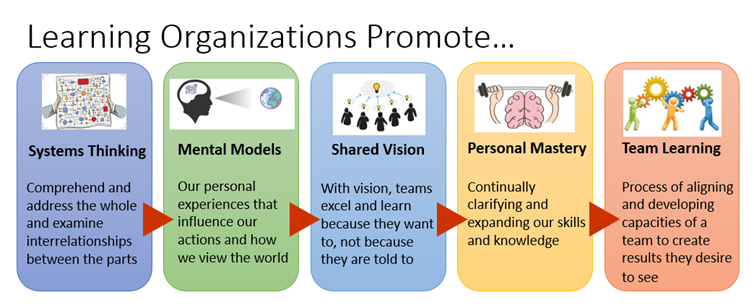

VISN 22 Story: Interview with the Southern Arizona VA Health Care System HRO Lead- Lorie Vakoc
Tell us about yourself? What is your background? I I’ve served in Federal Service for 30 years with a civilian career spanning the United States Air Force, Department of Justice, and the Department of Veterans Affairs (24 years as an active-duty Air Force spouse). I’ve been with the SAVAHCS for fourteen years, with 10 of those years serving as the Executive Assistant to the Director. I have three wonderful adult children whom I am very proud of (also Civil Servants serving in Tucson (USAF, DOJ, and VA)! They were Air Force brats and spent many years in Germany and Italy, including their high school years at Aviano Air Base! I have six grandchildren who are the joy of my life! They range in ages from 19 years old to the baby of the family (Riley) at 7! We have a very close-knit family and spend a lot of time together, including a family trip each year. We are shooting for Italy the summer of 2025! My hobbies are art, travel, and writing.
How long have you been the HRO Lead? In February of 2022 I was selected to serve as the HRO Lead for SAVAHCS. Prior to my selection, I was fortunate to follow a SAVAHCS staff member detailed as an HRO lead for a period of 90 days (phenomenal groundwork), and several years of development of foundational practice pathways through the exceptional leadership of our HRO Clinical Champion, Dr. J Edward Maddela, and already established, strong HRO foundational practice champions.
How is the SAVAHCS making high reliability a part of its culture? The past 14 years of my career at the SAVAHCS have been the highlight of my career. We have an incredible mission, and an even more incredible culture here. Many of our staff are Veterans themselves, and our staff truly do embody the tenets of servant leaders! We have high reliability embedded in our culture through a focus on improving reliability through continuous process improvement, building a culture of safety, and our leaders modeling what a just culture looks like. This last statement on Just Culture is key in making high reliability a part of our culture here and “just the way we conduct business.” We’ve also consciously included HRO topics and discussions in our Safety Forums, Employee Town Halls, Leadership Meetings, and facility wide staff meeting agenda templates. We also embed HRO as part of our culture through leadership visibility, modeling, and participation in all the venues listed above.
How is high reliability embedded into your leadership rounding, safety values, and continuous process improvement? We are focused on becoming a continuous learning organization that consistently focuses on improvements to Veteran care and translating our safety priorities into actions. We have embedded high reliability foundational practices in our leadership rounding, safety values, and continuous process improvement through staff commitment, timelines, accountability, and follow through. As part of our CPI foundational practice, we have refreshed our Enterprise Huddle to enhance visibility and transparency, enabling more efficient tri-directional communication and fostered psychological safety and community by connecting SAVAHCS leaders to foster trust and built momentum for cultural change. Our monthly Safety Forums have gained momentum and increased in participation over the past six months with a focus on safety as our top priority. Our safety values are embedded by applying a SAVAHCS wide commitment to Zero Harm by developing a strong safety culture of empowered, engaged staff who are supported by our leadership team through CPI initiatives that improve patient safety as well as enhance leadership rounding (addressing and closing the loop on safety issues) to solidify our True North: It’s About the Veteran.
What high reliability best practices have you implemented? We recently shared a best practice with the V22 HRO leads for our monthly Safety Forum standard work. This standard work model included metrics, schedules, CEUs, action trackers, etc. Kudos to our Tucson Foundational Practices Safety Forum Workgroup leads for developing this best practice! In closing, I always share in our HRO forums that we are a HRO team of 3,000+ strong in Tucson!
|
 |
|
Culture of Safety |

Call to action from the VISN 22 Patient Safety Officer- Brittany L. Cato
My charge to you, let’s be preoccupied with failure!
Close calls are often forgotten and shrugged off. But guess what? VISN 22 promotes reporting and learning from close calls.
When a close call happens, something went wrong, unexpected or intervened by chance. As a healthcare system, we analyze close calls to investigate opportunities to improve. The next time it happens, could potentially lead to harm, or even death. We don’t want to get to that point.
Close calls represent a potential point of weakness and can be viewed as a proactive approach. Proactively analyzing close calls (reviewing incident trends) overtime can identify patterns before safety is compromised. Let’s work together as a healthcare team in pulling in the same direction toward safer care and being preoccupied with failure.
Becoming an HRO, we will learn from our close calls and developed an enriched understanding before a harm event occurs. My charge to you, is to be preoccupied with failure. Learning from close calls and decreasing adverse events: Anticipating Risk.
VISN 22, What Does Safety Mean to You?
|
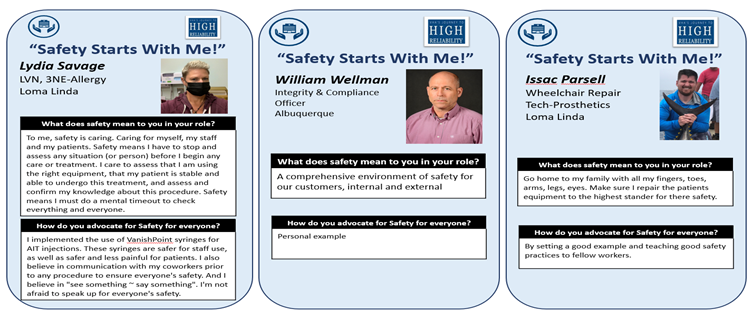 Throughout our organization, safety values and practices are used to prevent harm and learn from mistakes. This quarter we focus on the following HRO principles. (October) Duty to Speak Up everyone has a Duty to Speak Up when they see a safety issue, and leaders have a duty to listen and respond to the concerns that staff members raise. (November) Respect for People ensures everyone feels they can share information with the goal of improving patient care. (December) Clear Communications requires using standard words, tools, and processes to communicate clearly and simply.
NCPS Training
What is NCPS Team Training?
NCPS Team Training teaches front-line clinical teams specific safety behaviors for application in the everyday work environment where hands touch patients. This multi-disciplinary team training, with roots in aviation’s Crew Resource Management, is an integral part of the VHA’s commitment to zero harm.
What is the purpose of NCPS Team Training?
The goal Team Training is to create high functioning clinical teams. The behaviors and tools comprising Team Training help avoid patient harm by recognizing and managing risks and threats in the clinical setting. Team Training safety behaviors also assist teams in detecting and handling small errors in daily work so they don’t result in larger or catastrophic failures.
In NCPS Team Training you will learn how to:
-
View human error from a systems perspective
-
Apply practical leadership strategies to maximize team engagement and information sharing
-
Mitigate threats to information processing and decision making
-
Improve situational awareness and team decision making
-
Respond to operation failures using standardized leadership tools
-
Apply the Effective Followership Algorithm to escalate and resolve safety concerns
As part of NCPS Team Training you will implement what you've learned in a Unit-based Safety Initiative.
 |
|
Continuous Process Improvement |
Across our organization, we use effective tools for continuous learning and improvement. By striving for Zero Harm in a Culture of Excellence, where harm prevention and continuous process improvement are second nature to all staff members, we can dramatically improve the way we delivery care to our Veterans.
Seeking improvements aligns with the continuous journey to become a High Reliability Organization. This effort includes promoting an improvement culture that focuses on safety and zero harm.
VHA Standardized Lean Training curricula applies Lean thinking and methods to enhance organizational effectiveness by improving processes and reducing waste. Lean is widely used globally across settings to support efficient health care.
To learn more about how to implement daily continuous improvement management systems, tracking of improvement efforts and learn a deep exploration of Lean methodologies, click the link to the QuITT repository (below) or contact the VISN 22 Systems Redesign Health Systems Specialist Scott McRoberts, scott.mcroberts@va.gov.
HeRO Awards
The National HeRO Award is the highest level of HRO recognition available within VHA and is reserved to honor staff members who advance VHA's journey to High Reliability through demonstration of VHA's HRO Principles in action.
These awards reinforce the ADKAR Change Model. Nominees are recognized based on demonstration of the following 5 HRO Principles: 1) Sensitivity to Operations, 2) Preoccupation with Failure, 3) Reluctance to Simplify, 4) Commitment to Resilience, and 5) Deference to Expertise.
Calendar Year 2022 4th quarter HeRO Award submissions are open effective October 1, 2022 and will close on November 18, 2022. Nominee names are forwarded to VA Central Office for nationwide competition.To nominate your facility staff for the HeRO Award Program, visit our VISN 22 submission portal. For more information about the HeRO Award, please visit the national HRO SharePoint.
VISN 22 Calendar Year 2022 3rd Quarter HeRO Award Nominees
Let's celebrate and applaud the VISN 22 Calendar Year 2022 3rd quarter HeRO Award nominations sent up to national for review. Thank you for capturing the great work being done in VISN 22!
- VA Long Beach Healthcare System, Non-Clinical Individual
Fredrick McNeil
- VA San Diego Healthcare System, Clinical Individual
Joan Verzosa
- VA San Diego Healthcare System, Non-Clinical Team
Gianna Fimbres David Haas
- VA Greater Los Angeles Healthcare System, Clinical Team
Olivia Jean Jordan Ashley Ingram-T’siobbel Jiwen Li Anjani T. Reddy
Amit Kothari Folasade P. May
To view the VISN 22 Calendar Year 2022 3rd quarter submissions, click HERE!
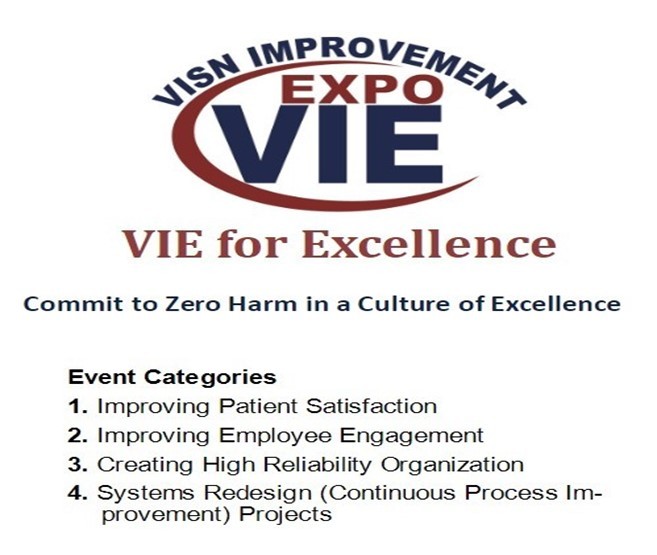 The VISN 22 Improvement Expo (VIE) identifies field-developed innovations that promote positive outcomes and improved experiences for Veterans and employees. The competition spotlights dedicated VISN 22 employees who are addressing some of the toughest challenges across VHA and provides a platform to bring exposure from all levels of leadership.
Congratulations to the VISN 22 Improvement Expo Winners!
VA Long Beach Healthcare System
-
Sandra Park (Remote Occupancy Sensors to Improve Clinic Utilization and Increase Access to Care for our Veterans)
-
Michael Hollifield (SGB for PTSD Innovation Program-SPIP)
Phoenix VA Health Care System
-
Ryan Pinick (Community Care Mammography Results Using DICOM Importer III)
Southern Arizona VA Health Care System
-
Todd Thompson (Post-Acute Home Care Initiative: New Directions in Transitional Care for High Utilizers)
New Mexico VA Health Care System
-
Sarah Baron (Heart Function Clinic)
Northern Arizona VA Health Care System
-
Janee Lai (Diabetes Technology Education and Monitoring Program)
To see all 2022 VISN 22 VIE submissions, click HERE!
 |
|
QUITT is VHA's centralized improvement project tracking repository managed by the Office of Systems Redesign and Improvement.
Link to QuITT Repository
|
Communications to Support HRO Behaviors
Is there specific change management training I can take to help me understand how to apply change management strategies?
VISN HRO Leads and Champions and two representatives from each medical center were provided an opportunity to participate in Change Practitioner training. This training focused on Prosci® Change Management methodology and provided a baseline understanding of how to apply change management strategies. There are a number of tools and resources available to you and to inquire about future change management training, please look at the Smart Change Toolkit.
What tools can I use to begin implementing change management within my organization?
- Use the Smart Change Toolkit to align your organizational goals to a formal change management strategy tailored to your organization
- Identify critical roles that will help support your change management plan by using the Sponsor Roadmap template
- Develop a communication plan for your facility on how to effectively communicate about changes related to HRO
- Pro-actively develop a plan to help your organization effectively plan for and manage potential resistance
VISN 22/Facility HRO Information
Get involved today, contact your facility HRO POC!
Note: All completions are current through September 23, 2022.
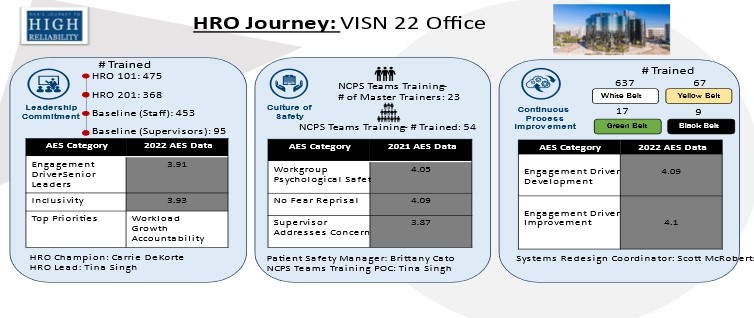 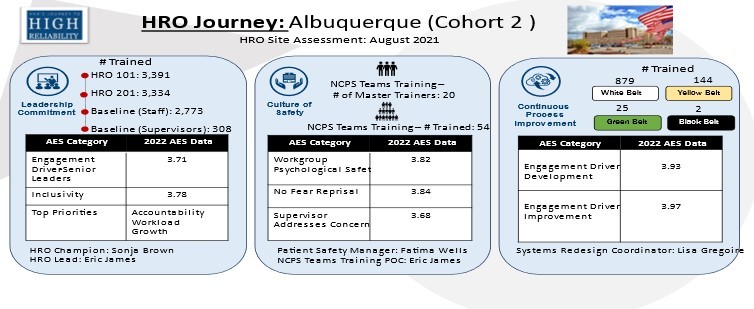 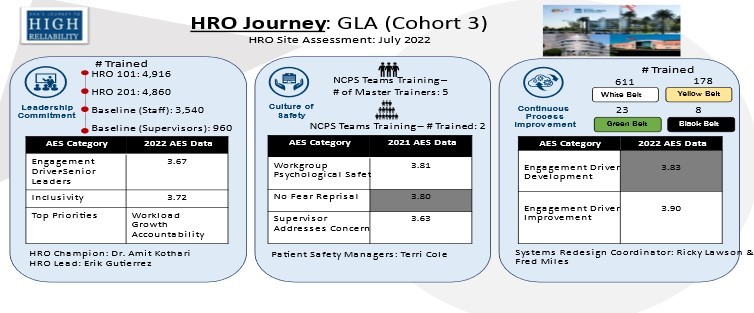 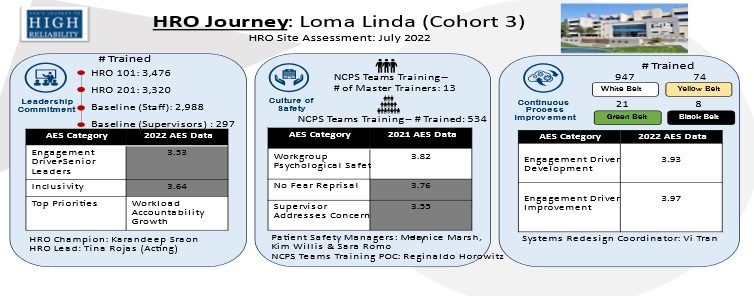 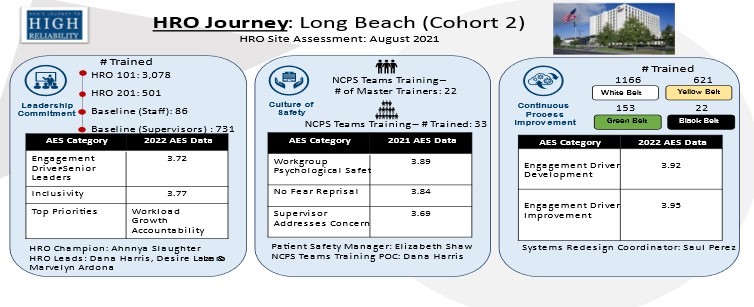 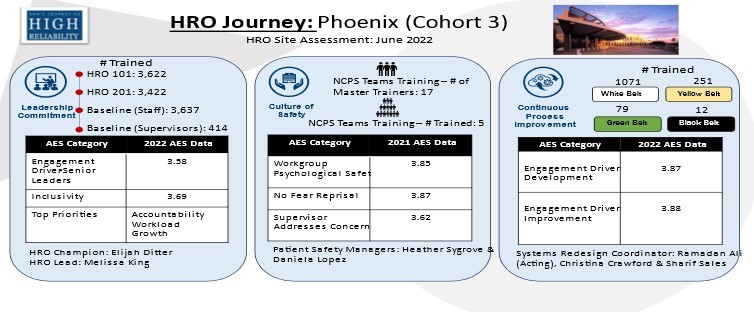 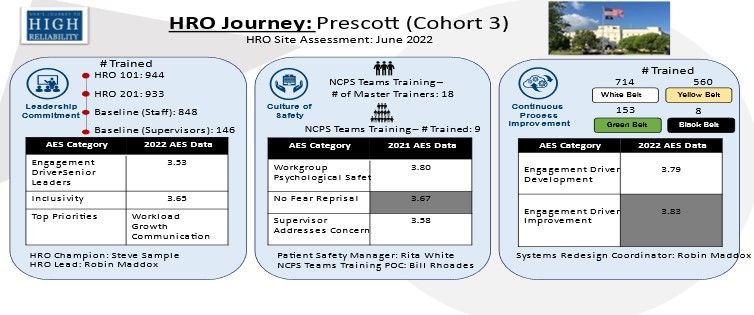 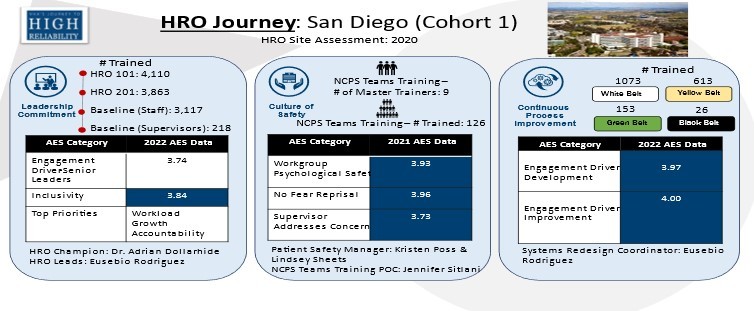 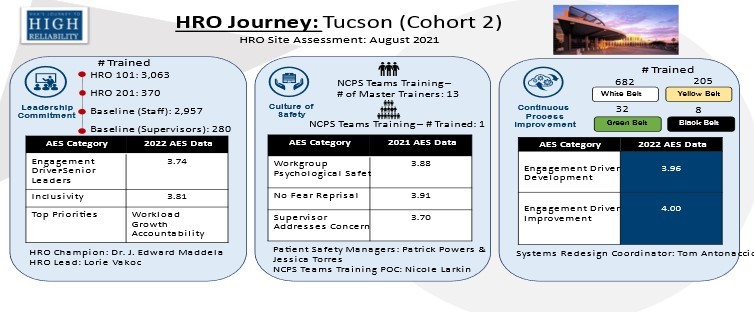
|